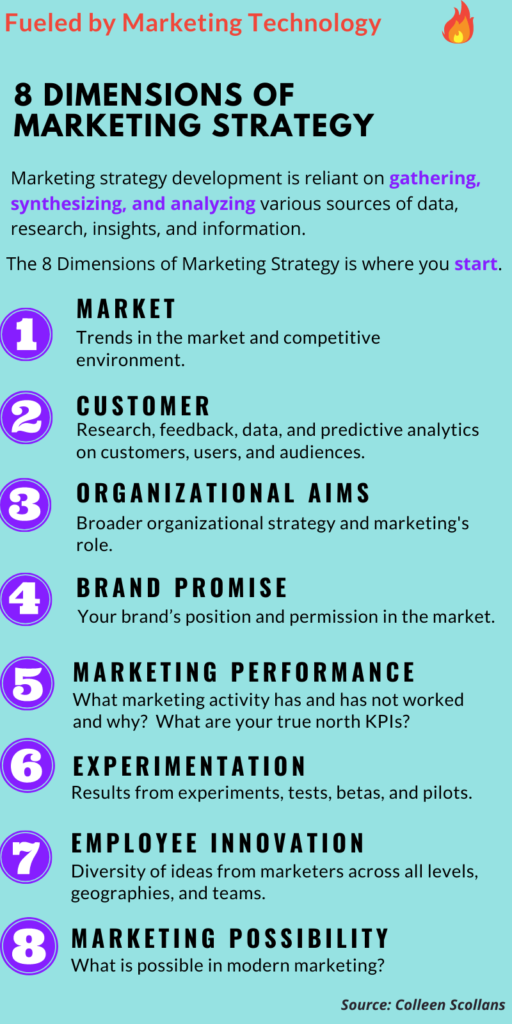
Introducing the 8 Dimensions
Your marketing strategy is your blueprint for marketing success. It outlines what you want to achieve, why you want to achieve it, and how you are going to get there. A well-designed marketing strategy framework for team objectives, departmental measures of success, and cross-team communication. It can also help drive organizational alignment by ensuring that marketing is “pulling in the same direction” as the organization overall, and that leadership and colleagues in other functional areas understand how marketing’s remit and “plan of attack” support organizational strategy.
The development of a winning marketing strategy is reliant on gathering, synthesizing, and analyzing various sources of data, research, insights, and information. I refer to these sources of information (and inspiration) as the 8 Dimensions of Marketing Strategy. These eight factors include:
- Market: Trends in the market and competitive environment.
- Customer: Research, feedback, data, and predictive analytics from customers, users, and audiences.
- Organizational Aims: Broader organizational strategy and marketing’s role in advancing that strategy.
- Brand Promise: Your brand’s position in the market. Customers have expectations of brands based on the brand values the organization communicates.
- Marketing Performance: What marketing activity has and has not worked and why? What are your “true north” key performance indicators (KPIs)?
- Experimentation: Results from experiments, tests, betas, and pilots.
- Employee Innovation: Diversity of ideas from marketers across all levels, geographies, and teams.
- Marketing Possibility: What is possible in modern marketing?
Fueled by Marketing Technology
While many of these sources of information have been employed for decades, modern marketing, fueled by marketing technology, has supercharged their use and potential effectiveness. Marketing Technology, also known as MarTech, is an umbrella term for all the tools and technologies that underpin modern marketing. Through marketing technology, modern marketing provides organizations with the opportunity to gather and analyze large volumes of data, automate rote tasks, and to deliver personalized experiences across many channels that improve business outcomes. There is simply too much to be gained by modern marketing to do things the old way.
In the publishing and association world, marketing technology is at the center of customer experience agendas helping organizations collect, analyze and harness data about customers and audiences.
- An audience is anyone that your brand engages with, or could potentially engage with, including prospects and readers.
- Customers, are a subset of your audience, and are those individuals and entities that have an active relationship with your band including buyers, subscribers, authors, event attendees, members, marketing opt-ins, social media followers, etc.
Aspirations to segment customers, personalize user experiences, or use data to find new audiences all rely on marketing technology. Marketing technology also enables marketers to be more efficient through automation of campaigns and streamlining of workflows that reduce costs and support scalability. Further, MarTech improves campaign and website performance, including the ability to test at a scale not before imaginable.
To be able to develop winning marketing and customer strategies, it is imperative that marketers understand marketing technology—what it is, how it is evolving, and how it can be a key plank in your strategy. While technology is always in service to strategy, without an adequate marketing technology frame of reference, your strategy may not be keeping up with audience expectations and competitive pressures. This is why the “8 Dimensions of Marketing Technology” is “fueled” by MarTech. Technology is a large part of what makes modern marketing possible.
Fluency with marketing technology can no longer be left to technology and digital teams – it is too central to the function of marketing today. Marketers must embrace and understand marketing technology in order to know how it might support their marketing strategy. Marketing technology is now so intertwined with marketing strategy and customer experience that it is impossible to decouple them. If your digital transformation agenda includes improved marketing performance, audience engagement, or improved customer experience—marketing leadership, armed with a solid understanding of MarTech—must have a critical seat at the digital transformation table.
5 Tips for Marketing Leaders Building Winning Marketing Strategies
For marketers looking to put the “8 Dimensions of Marketing Technology” in action, I offer the following five tips:
- Focus on the Basics – The fundamentals of marketing strategic development still hold true. Know your customers, study your market dynamics, and learn from past successes and failures.
- Think Customer First – Marketing strategy is customer strategy. Ensure you are aligned with the rest of your organization on the vision for customer experience (CX). Over-index on seeking regular feedback from your customers. Invest in tools that provide a robust single customer view and audience engagement analytics.
- Don’t Imitate; Differentiate – Too often organizations look to competitors and try and mimic what they do. The problem is by the time they “catch-up” the competitor has moved on or the “me-too” offering falls flat. Build a strategy that is future-oriented and a true differentiator. This is especially true when it comes to marketing technology choices.
- Set clear measurements of success – A marketing strategy is not simply an academic exercise. While it takes rigor and analytical discipline, it is meant to be actionable and measured.
- Embrace agility: Marketing plans can and should change. It is OK to fail fast and move on. Strategies should evolve in the light of new evidence. Where possible, test, experiment, and iterate. While setting an annual plan is good discipline, plans should be reviewed several times a year and always when there are changes in market dynamics.
Learn more
Are you interested in learning more about Marketing Technology, Customer Experience and Marketing strategy development? Contact us today to learn more and find out how we can help.




